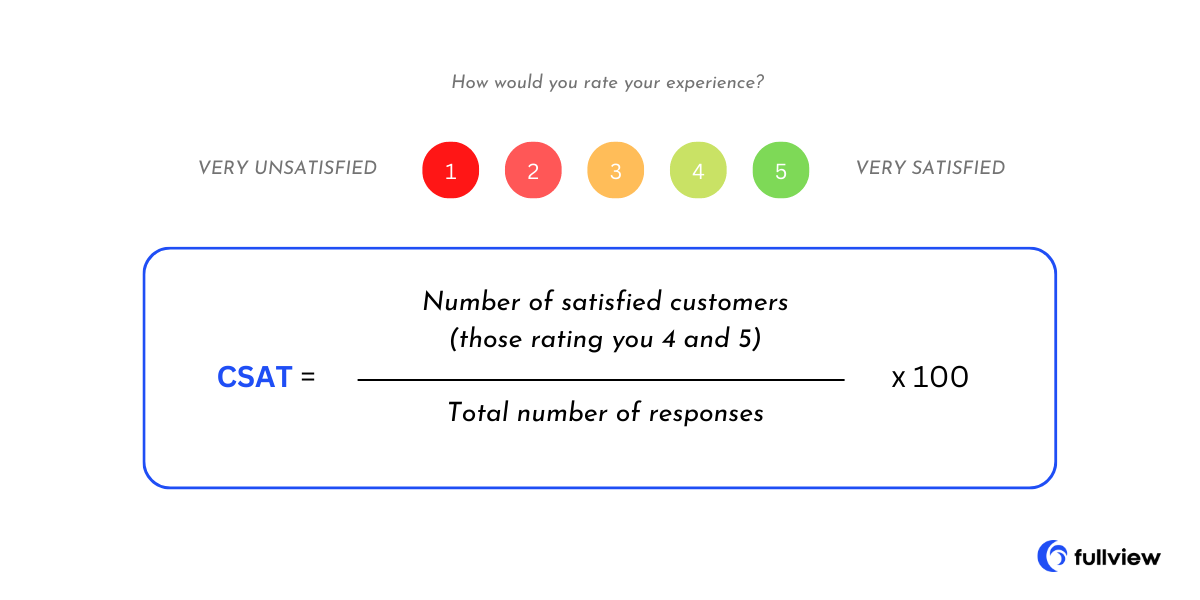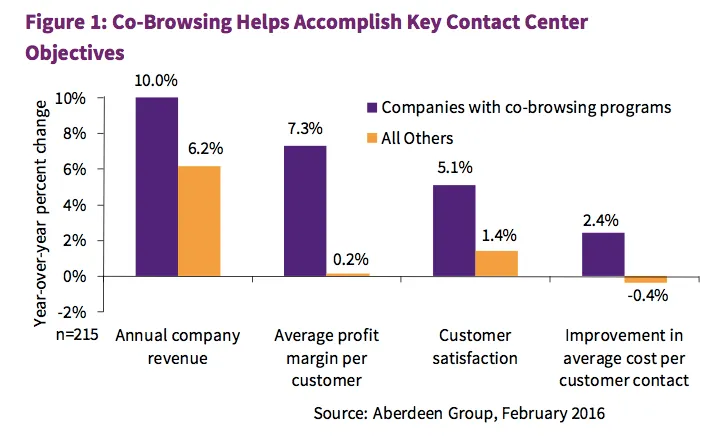PwC’s 2017/18 survey revealed that 59% of US customers will walk away from a company after multiple bad experiences, even if they love the company or its product, whereas 17% will do the same after a single bad experience. Similarly, 32% of all customers would stop shopping with a brand they previously liked if they had one negative experience. Those are interesting facts – bad customer experience will drive customers away faster than you might think. Learn how to fulfill the expectations of today’s customers and improve CSAT for a successful business year!

Table of Contents
What is CSAT
CSAT stands for customer satisfaction, which means how satisfied your customers are with your service.
Customer satisfaction scores, aka CSAT scores, are important because they allow you to figure out how happy your customers are with your service or product.
You might’ve seen those pop-ups that ask you to rate your satisfaction on a scale after you’ve had an interaction with a support team.
Those CSAT scales could range from 1 to 10 or 1 to 5, starting from very unsatisfied to very satisfied.
CSAT scores are used to improve customer satisfaction on the basis of direct customer feedback and then make changes to improve overall customer satisfaction and loyalty.
For example, a restaurant may use its CSAT score to see that a lot of people are complaining about the wait time, so they could hire more staff to decrease wait times.
CSAT is calculated by the number of satisfied customers (those who’ve rated you 4 and 5) divided by the total number of responses.

Must Read: 10 Key Differences Between Good and Great Customer Service
15 Ways to Improve CSAT
According to 2023 CX trends by Forrester, the quality of customer experience is not getting any better.
During 2021-22, the CX index dropped for the first time in seven years.
That means companies aren’t prioritizing customer experience over internal operations.
Furthermore, the same study also revealed that “companies are less customer-obsessed”.
That means more avenues will open up for those companies that focus deeply on CX rather than considering it a triviality.
Include the following CSAT best practices to provide exceptional customer support and gain a massive competitive edge.
-
Implement an Omnichannel Strategy
Omnichannel support has become a necessity in the modern world.
It not only means having multiple modes of communication available to the customer but also integrating each channel with another.
Companies with the best omnichannel customer strategy convert 89% of buyers into loyal customers. That’s a huge number!
That means a customer should be able to approach your business through live chat, email, phone, or social media.
This can be better explained in this manner – a potential customer approaches you on social media for a query, you bring them on call for a detailed discussion, and if all goes well, you follow up with them through email.
In the example above, you can see how all communication channels are connected so that a different channel doesn’t lose the context of the same customer.
That’s also the difference between multichannel support and omnichannel support – the modes of communication in the former aren’t interconnected with each other.
The modern world is digitized. You cannot rely on a single, traditional communication channel such as calls for customers to approach you.
That’s also why more businesses are transitioning from call centers to contact centers.
Once you open various avenues for a customer to approach you, you’re allowing them to contact you based on their preference and ease.
Thus, an omnichannel strategy will not only naturally improve CSAT but also increase trust and build brand image.
-
Provide 24/7 Customer Support Through Live Chat
The internet has changed your usual customer dynamics.
More companies have started moving towards 24/7 customer support to accommodate customers who live in different time zones.
A huge number of people also work the night shift, which means they’re more active during night time rather than daytime.
As a business, you ultimately need any and every customer you can get.
That’s why you need to have round-the-clock support to grab as many leads as possible.
This does not mean that having non-stop customer support will definitely increase your sales.
However, it is a good CSAT practice to have 24/7 customer assistance because it will help build your brand image and improve customer retention.
If you’re a small business and are wondering how you can manage that, you can leverage chatbots to your advantage.
Hiring agents can be costly and difficult, there’s no doubt. However, having a live chat widget on your website will help you massively.
Surprisingly, the benefits of live chat support are huge but most businesses are just unaware of them.
In short, 24/7 customer support combined with live chat improves CSAT, builds brand image and helps with customer acquisition.
-
Outsource Your Customer Support
Outsourcing is when you hire a third party to do a task on your behalf.
When you outsource your customer support to a third party, it is called customer support outsourcing. Such parties are called Business Process Outsourcing (BPO) companies.
Once a business grows, managing customer support can get difficult as time passes due to a larger volume of incoming customer inquiries.
When you outsource your business to a BPO firm, you don’t have to worry about increasing chat volumes. You can simply increase an agent.
That’s how outsourcing companies work – you can choose a plan to go with your needs and then change it accordingly.
Outsourced companies have expert agents that go through proper training before they’re hired, they’re multilingual and offer 24/7 support as well.
Those are just a few benefits of outsourcing companies. In short, outsourcing customer support can help massively with enhancing your customer satisfaction.
-
Personalize Customer Interactions
The ultimate goal of customer service should be to make your customers feel special.
According to Salesforce, 84% of consumers view personalized support as a key factor in winning their business.
Three qualities are a must-have in a customer support agent – empathy, active listening, and effective communication.
However, a lot of times canned and automatic responses can sound very robotic and inhuman. It’s personal experience talking, really.
You’re asking for something else as a customer, but you get a scripted response that simply tells you that your concern has been heard when it really hasn’t.
It only frustrates you further.
That’s why, as a customer support rep, you need to leverage data and analytics to your benefit.
Based on the data you gather from customer history, for example, you can personalize your responses accordingly.
-
Monitor and Analyze Customer Feedback
Customer feedback is one of the best ways to improve CSAT because you directly understand what customers want from you.
According to a survey conducted by Microsoft, 52% of people around the globe believe that companies need to take action on the feedback provided by their customers.
By focusing on customer feedback and collecting insights, you can identify areas of improvement and implement necessary changes.
This demonstrates that you value customers’ opinions and are committed to addressing their concerns.
This will help you naturally improve CSAT and foster customer loyalty.
-
Provide Agents With the Latest Tools
Microsoft, in their 2017 Global State of customer service report, suggested that companies leverage AI and automated bots as soon as possible.
It is 2023 now, and most companies are tapping into the AI industry to gain competitive advantages over their rivals.
In fact, a study by Aberdeen Group reveals that companies using visual engagement tools, such as co-browsing and screen sharing, witness a 5.1% boost in customer satisfaction.
These tools improve the overall customer experience and they’re right there for you to use!
By leveraging these tools, you and your agents can swiftly resolve customer issues, leading to increased customer contentment.
-
Improve First Contact Resolution (FCR)
A study found that customer satisfaction rates drop by up to 45% if their issue isn’t resolved on first contact.
First Contact Resolution (FCR) means when a customer’s issue is resolved without getting deferred to an upcoming date or getting escalated.
To improve FCR, you can make it a KPI across your customer service team and for your agents.
That way, your agents will prioritize resolving issues right there rather than deferring them.
Having a knowledge base to which agents can refer also helps if they stumble across a customer whose issue falls out of their scope.
-
Offer Proactive Support
Being proactive in addressing customer concerns can lead to a dramatic increase in satisfaction.
A study by Enkata found that preemptive support can reduce call volumes by 30% and increase retention rates by 3-5%.
By anticipating and solving potential issues that could arise in the future, you are showing your commitment to enhancing the customer’s experience with your company.
Proactive support can be achieved through various means, such as monitoring social media for potential customer complaints, sending follow-up emails to check on customer satisfaction, and offering assistance before the customer has to reach out.
By staying one step ahead, you show customers that their needs are a top priority, leading to increased loyalty and better CSAT scores.
-
Assess Customer Journey to Eliminate Pain Points
Analyzing and optimizing the customer journey can have a significant impact on satisfaction.
According to McKinsey & Company, companies that optimize the customer journey see a 15-20% reduction in repeat service calls and a 20-25% growth in customer satisfaction.
Streamlining processes and removing friction points leads to a smoother and more enjoyable experience for customers, ultimately boosting satisfaction.
This can also be achieved by collecting customer feedback as stated above, mapping out the customer journey, and identifying areas for improvement.
By focusing on the customer’s perspective and addressing their pain points, companies can create a seamless experience that fosters long-term satisfaction and loyalty.
-
Empower Agents with Decision-Making Authority
Granting customer support agents the autonomy to make decisions can have a positive impact on CSAT scores.
A study by the Harvard Business Review found that organizations that empower their frontline employees experience a 28% increase in customer satisfaction ratings.
By giving agents the authority to make decisions, they can resolve issues more efficiently and effectively, leading to happier customers.
Empowering agents involves providing them with the necessary resources, training, and guidelines to make informed decisions, as well as fostering a supportive work environment that encourages independent problem-solving.
This approach not only boosts agent confidence and performance but also results in a more personalized and responsive customer support experience.
When customers feel that their concerns are being addressed promptly and tailored to their specific needs, their satisfaction and trust in the company grow, ultimately contributing to improved CSAT scores.
-
Distribute Time and Workload
Efficiently distributing workload and managing time can have a direct impact on customer satisfaction.
75% of customers expect service within the first five minutes of online contact, according to McKinsey.
By balancing workloads and prioritizing tasks, agents can provide timely and attentive support, enhancing the customer experience.
Implementing strategies like workload distribution tools, clearly defined roles, and performance monitoring can ensure that agents are working efficiently and effectively.
This allows them to focus on providing exceptional support, leading to increased customer satisfaction and loyalty.
-
Maintain a Positive Attitude Throughout
A positive attitude plays a crucial role in improving CSAT.
According to a study by Harvard Business Review, positive customer service interactions can result in customers spending up to 140% more with the company.
By fostering a friendly, solution-oriented approach, agents can create a pleasant support experience and contribute to higher satisfaction levels.
Encouraging positivity among your support team can be achieved through regular team-building activities, providing a supportive work environment, and recognizing agents’ accomplishments.
By promoting a positive attitude, companies can significantly impact the overall customer experience, leading to increased satisfaction and repeat business.
-
Arrange Training Workshops for Agents
Regular training workshops can directly impact CSAT.
According to Avanade, there’s a $3 return on every $1 spent on customer service, and customer service agents trained in empathy are twice as likely to be high performers, according to Salesforce.
Investing in continuous learning and skill development for agents helps them provide better support, leading to more satisfied customers.
Companies can implement ongoing training programs, such as workshops on product knowledge, communication skills, and problem-solving techniques.
By investing in agent development, you ensure that your support team is well-equipped to handle customer inquiries and issues effectively.
This not only boosts agent confidence and performance but also leads to increased customer satisfaction, as customers receive timely, knowledgeable, and empathetic support.
-
Use AI and Automation
AI and automation can significantly improve CSAT.
A study by IBM shows that AI-powered chatbots can successfully handle up to 80% of routine customer inquiries, leading to a 33% decrease in average handle time.
By using AI and automation to handle repetitive tasks, agents can focus on more complex issues, delivering faster and more effective support.
Implementing AI-powered tools, such as chatbots and virtual assistants, can help companies provide quick and accurate responses to common customer queries, freeing up agents to handle more nuanced issues.
Additionally, automation can streamline back-end processes, such as ticket routing and customer data management, allowing agents to access relevant information more quickly.
By leveraging these advanced technologies, companies can optimize their customer support operations and improve overall CSAT scores.
-
Benchmark Performances Against KPIs
Regularly benchmarking your customer support team’s performance against key performance indicators (KPIs) can provide valuable insights into areas for improvement and help drive customer satisfaction.
Establishing and tracking KPIs, such as first contact resolution, average handle time, and customer effort score, can help identify trends and areas of concern.
By setting targets and monitoring progress, you can ensure that your support team is continuously striving to improve their performance and deliver exceptional customer service.
This focus on improvement and accountability can lead to increased customer satisfaction and stronger customer relationships.
Also Read: Can Artificial Intelligence (AI) Call Center Replace Human Agents?
Conclusion – 15 Ways to Improve CSAT
In conclusion, improving CSAT scores involves a combination of strategies that focus on enhancing the customer experience, optimizing support team operations, and leveraging technology.
By investing in agent development, implementing AI and automation, and continuously monitoring performance against KPIs, companies can drive customer satisfaction and foster long-term loyalty.


![What is Shrinkage in the Call Center [Updated 2025]](https://www.hiredsupport.com/wp-content/uploads/2025/04/What-is-Shrinkage-in-Call-Center-1-300x169.png)
